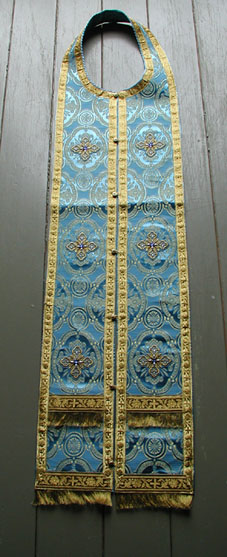Vesting of Clergy
Before the "Orthros" or Matins (morning prayer), the Priest prepares himself for the Divine Liturgy by special prayers recited outside the Iconostasion (Altar Screen) before the Royal Doors. After paying his respects by kissing the Holy Icons of the Iconostasion, he enters the Sanctuary through the North Door saying:
I will enter Thy House, and in Thy fear, I will worship toward Thy Holy Temple.
Having entered the Sanctuary, the Priest wears his Vestments. The Liturgical vestments come from the days of the first priests in the Old Testament. The purpose of vestments were "for glory and for beauty" (Ex 28:2 & 40), to enable the leaders for "ministering in the holy place" (Ex 35:19, 39:1, 41), "that they may serve Me as priests" (Ex 28:4, 41). Decorating of vestments comes from Old Testament time as well when the garments were bejeweled and made of beautifully colored "fine linen," skillfully worked," and embroidered with needlework (Ex 28:6, 36, 39), with bells of gold (Ex 28:33), and with a plate of gold engraved with the inscription "Holy is the Lord" (Ex 28:36). They also prefigure our deification (2 Peter 1:4) where we "put off this lowly body and shine brighter than the sun as revealed in Christ's divine light at the Transfiguration" (Philippians 2:20-21).
For each ofthe five (5) pieces a special prayer is recited:
1. STICHARION:
The Sticharion is the inner garment, reaching to the floor. It signifies the purity of heart that should be inseparable from the Priestly Office. It states Christ's purity and illumination as well as the purity and brightness of the Holy Angels. Worn as the undermost vestment by bishops and priests, it is usually made from a simple white or gold fabric. It is worn as an outer vestment by deacons and subdeacons when it is usually more decorated. It is open down the sides but held shut with baubles or buttons. Some jurisdictions still call the sticharion which the deacon wears a dalmatikon in accordance with the terminology the universal Church used at the time of its introduction in the fourth century. It is also worn as the outer garment by acolytes. It usually has a cross embroidered or appliquéd to the center of the back, between the shoulder blades. The following prayer is said when vesting:
My soul shall exalt in the Lord, for He has endued me with the robe of salvation, and with the garment of joy has He clothed me. He has set a crown on my head like a bridegroom, and like a bride He has adorned me with comeliness (Isaiah Chapter 61, Verse 10).
 EPITRACHELION:
EPITRACHELION:
The Epitrachelion (stole: meaning "on the neck") signifies
the outpouring of Grace from Above on the Priest. It
also symbolizes the Cross carried by our Lord upon His
shoulders. A church service cannot be celebrated without it.
It denotes the balance, weight and responsibility that
priests have for all our souls. The tassels that hang at the
lower part of the Stole represent our souls that hang on the
Spiritual Fathers neck.
Blessed is God, Who pours His grace on His Priests, like the balm on the head, that ran down the beard, even Aaron's beard, down to the skirts of his garment (Psalm 133, Verse 2).
3. ZONE:
The Zoni (Belt) is worn over the Sticharion and Epitrachelion.This girding shows a Priest's readiness for service and the strength he receives from the Holy Spirit to succeed in his mission.
Blessed is God Who girds me with strength, and makes my way perfect(Psalm 133, Verse 2).
EPIMANIKA:
The Epimanika (2 Pieces - Cuffs) symbolize God's
creative hands and His omnipotence. The cords which tie
them represent the rope with which the Lord was tied.
Putting on the first Epimanika - right cuff this prayer is said"
Thy right hand, O Lord, is glorified in strength. Thy right hand, O Lord, hast shattered the enemy, and through the multitude of Thy glory Thou hast crushed Thine adversaries (Exodus Chapter 15, Verses 6-7).
Putting on the second Epimanika - left cuff the following prayer is recited.
Thy hands have made me and molded me; given me understanding, and I will learn Thy Commandments (Psalm 119, Verse 73).
PHELONION
(Chasuble - The outer vestment in form of cape):
The Phelonion signifies the crimson Robe, with which the
soldier clothed our Lord Jesus to mock Him while he was in
the Praetorium.
Let Thy Priest be clothed with righteousness; and let Thy Saints shout for joy, always, now and ever, and to the ages of ages. Amen. (Psalm 132, Verse 9)
Preparing to wear each of these parts of his Vestments, the Priest blesses them with the sign of the cross and kisses them. He then washes his hands to signify his cleanliness, praying:
I will wash my hands among the innocent, and so will I go round Thine Altar, O Lord (Psalm 26, Verse 6).
Vested and completing the Proskomide, the Priest is prepared to begin the Divine Liturgy.
